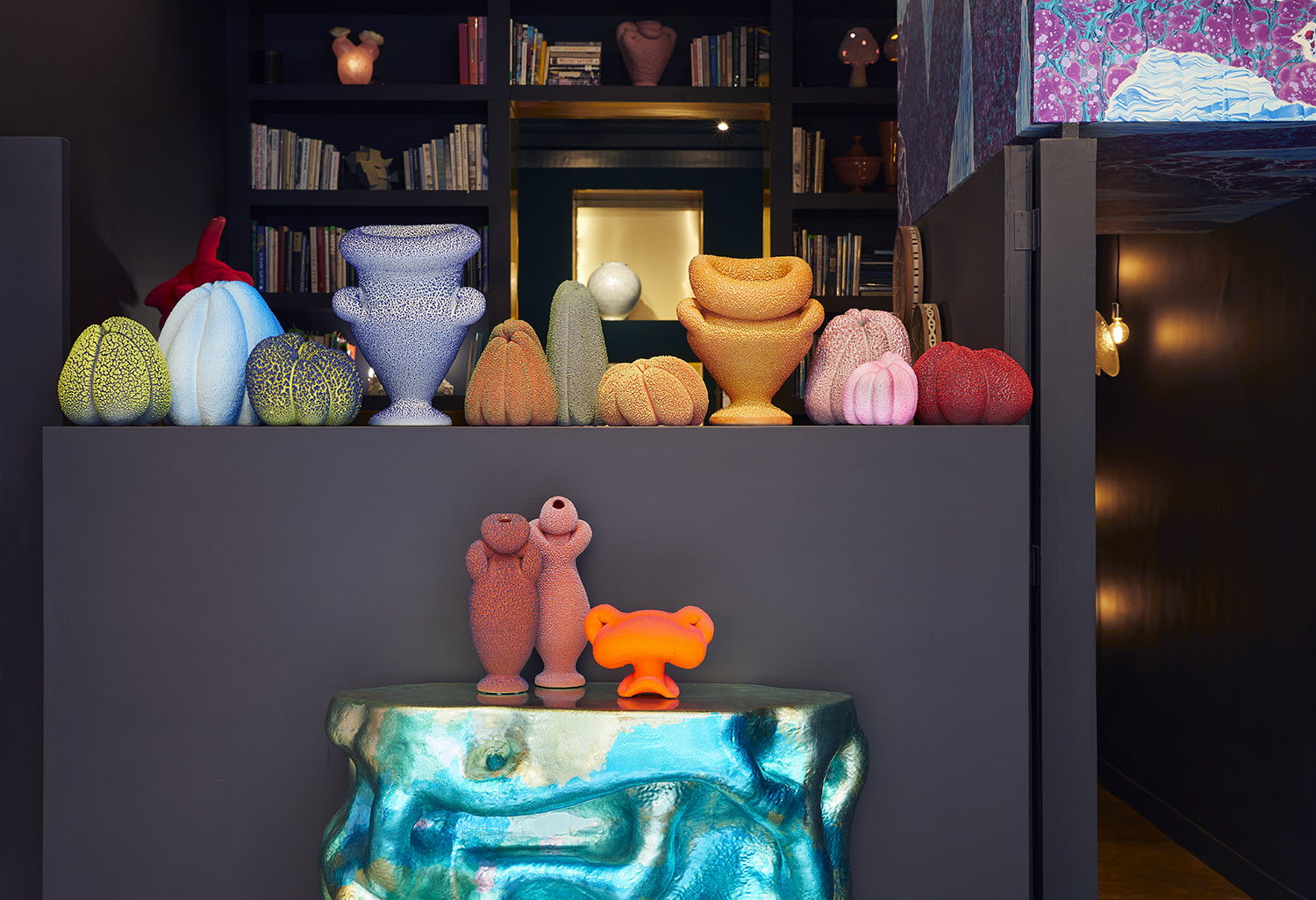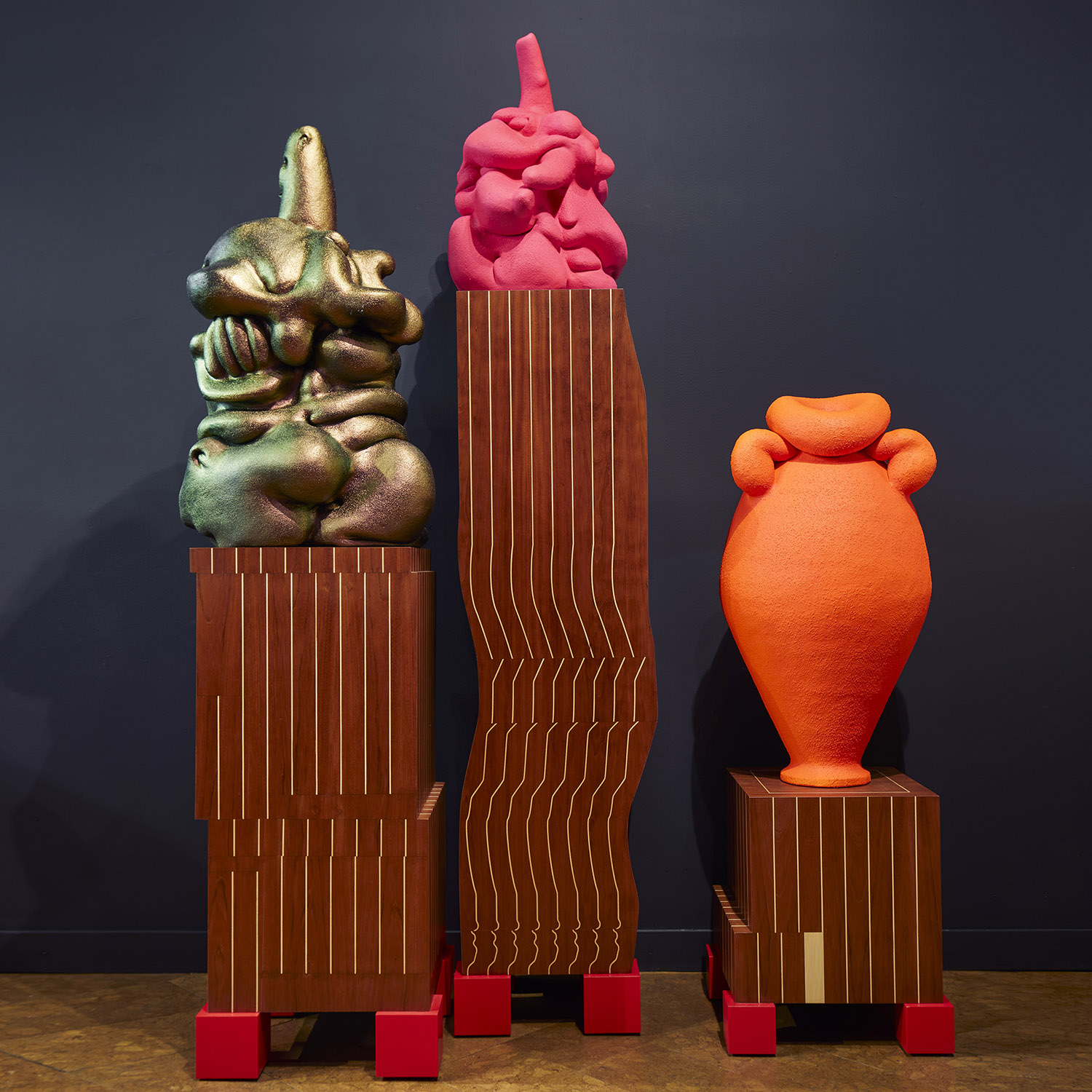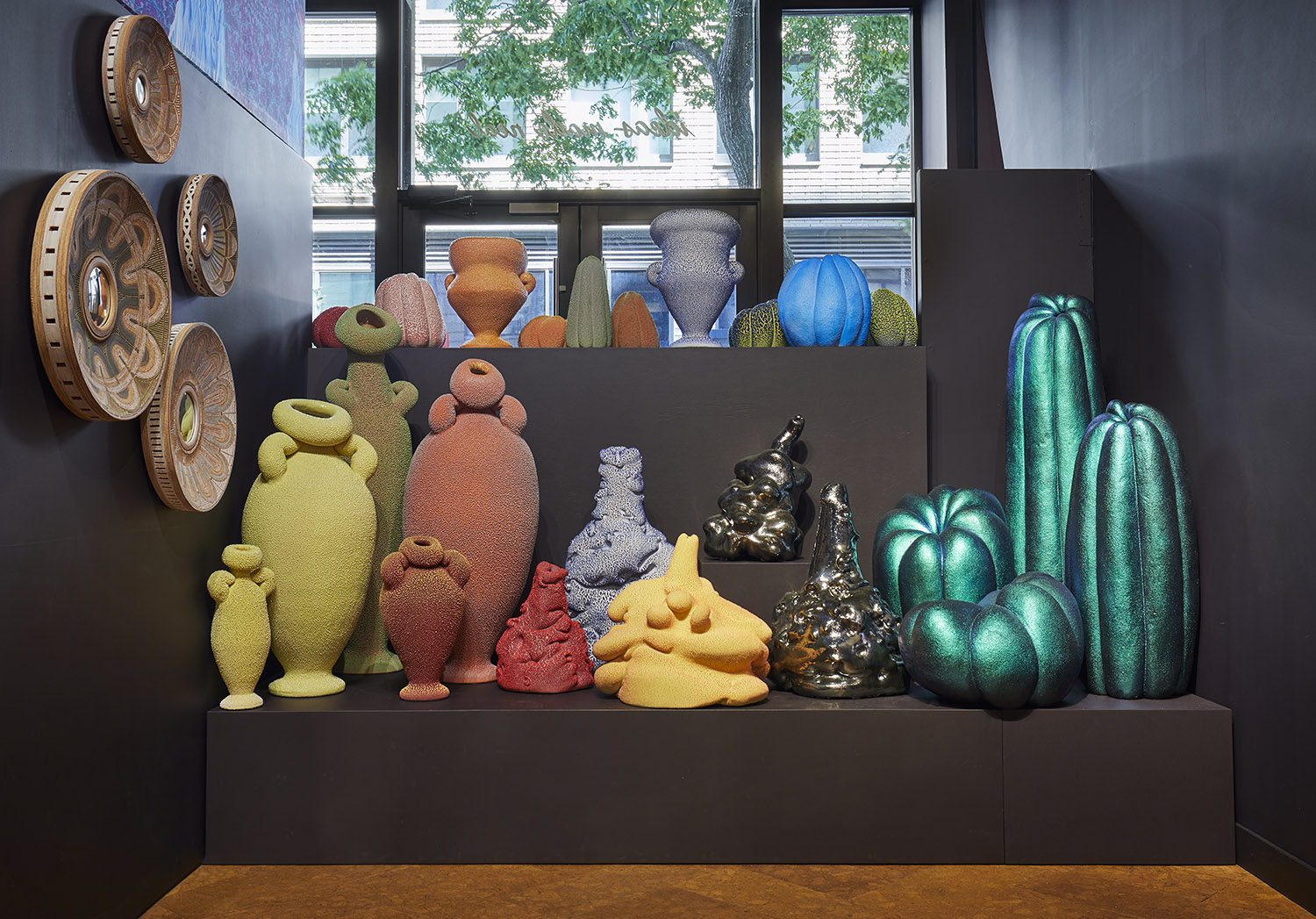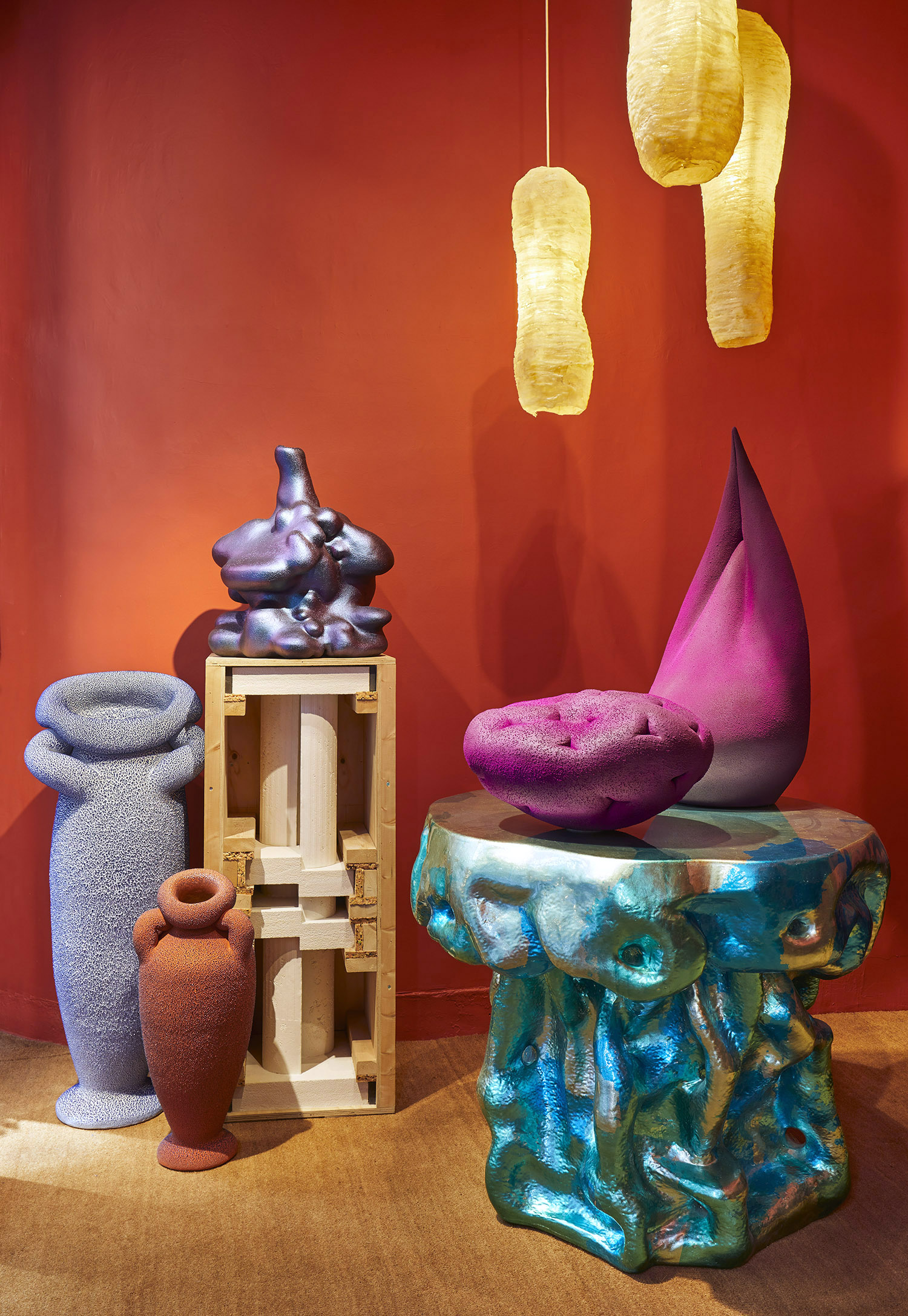Maxwell Mustardo: The Substance of Style
| September 14 - November 18, 2022 |

At the core of Maxwell Mustardo’s first New York solo exhibition, is his development of several archetypical forms in ceramic, pushed and pulled in proportion and scale. Their alteration conjures cartoonish digital variations while anticipating the transmogrification that time and ever-changing demands perform on traditional shapes as they weather history’s progress. Each of the forms, the Amphora, Gadroon and Stack, are rendered in monumental scale as exalted representations of his new symbolic typologies. Each one references and reconfigures historical ceramic forms that are already replete with multilayered associations. A number of the works in the exhibition were recently included in his first solo museum show at the Hunterdon Art Museum, this work has been supplemented and updated to present a more cohesive vision. In glib parlance, substance and style are antithetical, but in matters of art, they are the two inseparable pillars underpinning the endeavor. To put the terms on a solid footing, 'style' is a characteristic way of making a thing, with reference to appearance or form, while substance is the essential nature of a thing, that of which it physically consists of. As Maxwell Mustardo’s new body of work perfectly demonstrates, art’s success rests on the manner by which the physical is manipulated to embody and represent an idea. Wielding these two pillars of substance and style, Maxwell harmoniously integrates formal historical and contemporary references, using organic and synthetic material, to create a distilled representation of our time, defined by the intersection of the real and the virtual. His endeavors reveal, with proud certainty, that the REAL remains unbeatable, as the mother of the virtual. At a glance it is evident that Maxwell’s work is perfectly synchronized with our era of ravenous digital excess. As a Millennial, he is in the first generation to live a life fully integrated with the digital. Having graduated from Alfred University in 2017, Maxwell is keenly aware of the Instagram influence. Glenn Adamson memorably explored this influence in his essay "Rise of the Hyper Pot", a contemporary answer of sorts to Brian O'Doherty's influential 1976 essay "Inside the White Cube", similarly addressing context and presentation of art. In the halcyon days of 1976, O’Doherty observed that "The ideal gallery subtracts from the artwork all cues that interfere with the fact that it is 'art'." At the time of that statement, Dada and Fluxus were well established movements working to reintegrate art into the real world through ‘actions’ and ‘happenings’. Today, Millennials like Maxwell fight a new battle arising from the consequences; clamoring for attention that now must be hunted and stolen by the millisecond as people scroll through their little black mirrors and buy art from tiny jpgs on their screen. The screen is the new context that gave birth to the work Adamson characterizes thus
The artists Adamson references to establish his description are largely a generation removed from Maxwell, whose approach lacks any hint of cynicism or pandering. Instead, he simply accepts as a given the competitive nature of the environment, be it digital, or our visually overstimulated quotidian existence, and produces work organically suited to the context; rich and complex, but also distinctively graphic, plucking iconic forms from history like a carillonneur ringing a bell.
|

Maxwell does not leave his chosen iconic forms unmolested. With comically bulging and voluptuous profiles, as well as shockingly saturated and glowing coloration, it is easy to imagine Maxwell’s work being inflated and distorted digitally, like virtual putty on a monitor. This aesthetic arises unforced, intuitively, much as it did when 'Pictures Generation' artists embraced the language of the film and advertising industry. Maxwell similarly embraces the effects of filters and digital manipulation that we interact with daily on our screens. Yet, he also proudly revels in the clay’s material properties – it’s heft, the tactile glaze, the shimmering PVC coating. It is impossible to not experience his work foremost as an overt celebration of skillfully executed Bacchanalian physicality. Its bilingual nature lets it sparkle on screen but burst with full force only in real life, it’s native tongue. Real life is surprisingly kind to Maxwell’s shapes in rudimentary clay. Consider that it takes enormous skill and dedication to shape siren-like beauty out of thick, sticky mud – and yet for eons artists have done so. With each attempt, successive artists have refined techniques and developed possibilities in imaginative and often fantastical ways, this is the tradition that Maxwell knowingly enjoins. Yet, despite all the evolution, he recognizes that certain forms seem almost immutable in their appeal and persistence; the simple cylinder, the spheroid, and the frequent invocation of gourd-like bodies. Like a canvas, so limited in scale and form, these vessels seem nonetheless to have room for infinite variation without losing the connection to the primary essence of the form. In this new body of work, Maxwell simultaneously champions and rebels from this tradition that he knows he can’t escape. As a rebel, he pokes and plies the contours to comically violate the form, reducing profundity to emoji-like incarnations. As champion, he waves a wand over unclean and unwieldy mud to resurrect and enshrine it in contemporary iconography. That mud, lowly mud can prove the superiority of the real, over the fantasy of the virtual, is deliciously satisfying. Not that this makes Maxwell a traditionalist by any stretch – coating his works in a candy shell of plastic, sprayed, foamy PVC and color shifting iridescent pigments, he pulls this mud into our synthetic modern day. The two materials are uncannily well suited; mud as the original, organic ‘plastic’ material and PVC as its purest, toxic embodiment. Before you become too comfortable with that yin-yang dance, Maxwell has snuck in traditional vitrified glaze surfaces almost indistinguishable from the fluffy PVC, perfectly embodying the disconcerting push-pull of our surface vs substance, analog vs digital existence. Maxwell’s style is the synthesis and summation of our peculiar moment in history, which he captures with the aid of substantive skill, ingenious analysis, and interpretation of historical forms. History is Maxwell’s dependable foundation, and one that he is demonstrably proud to cite. It echoes through his contemporary iteration, reviving and deepening the original idea and its meaning. Ideas, and the memory of those ideas, are the building blocks of culture, so Maxwell cannily quotes the ideas embedded in forms that help us connect to a shared sense of purpose and hope. At the heart of Maxwell’s strategy is the recognition that our modes of expression are largely mimetic or evolutionary. Expression has meaning by virtue of evoking the familiar, summoning what has been done before. Through this performance Maxwell is distilling what we have seen to make it more powerful, more effective at evoking the appropriate reference, summoning a clearer and more relevant vision. To do this, Maxwell has identified the aesthetic essence of this digital moment we are in while acknowledging that the depth of the past is also readily available to us - and holds its own with the wonders and novelty of the present. Maxwell’s work identifies what is good and strong in this moment and makes it the focus of his endeavor by wrapping it around the enduring foundations of symbols of our past.
|

The amphora – the ancient, the classical, the iconic vessel form - draws us back to the very cradle of civilization, to survival in a world that we must manipulate for our own protection, in ways as a simple as storing water or food. There is hardly a new thing that can be said of the amphora, and that is exactly the point; it is a celebratory metaphor for human culture. The amphora has rightly become Maxwell’s most readily recognized from, one that he has now rendered over a hundred times in fabulously implausible proportions. In this exhibition the amphora appears for the first time in monumental size, human-scale, cheekily quoting the tradition of massive porcelain urns popularized by Jingdezhen manufacturers in the Qing dynasty, as well as the work of Toshiko Takaezu, at whose studio Maxwell now works in, and in whose kiln these giants were fired. In fact, it is easy to say that the monumental forms are a direct descendant of Takezu’s work; existing only by the grace of the facilities built by Takaezu who did so to conceptually reference and confront the body on equal footing. It is, in fact, the human-scale which drives home with finality Maxwell’s central conceit with the form, which he christens the "Anthropophora"; it is a symbol of us. Vessel as body is no innovation, but in making explicit our ability to see ourselves, as we are today, in our historical tools, Maxwell shows us how our tools shape us as we shape them. The amphora is an enduring and powerful symbol, which Maxwell revives with fresh relevance. It is, however, the toroid that is Maxwell’s true touchstone. Imagine a one-holed doughnut; this is a toroid. It is a form Maxwell has employed for years as the ideal vehicle for glaze tests. Formulating new glazes has long been an important element of his work, but rather than the traditional tile, the toroid allows Maxwell to better anticipate and perfect the real-world interaction of the glazed surface with light. The compound curves of the form make it ideal for observing lighting effects, and yet it is still a simple enough form to execute expeditiously for tests, as such, it has become his foundational form. As a direct result of a residency in Rome, where the artist observed Baroque architectural ornamentation of amphorae and krater, with deeply ribbed undersides (known as gadrooning), his toroid has now evolved. Applying gadrooning to the entire toroid body, effectively pulling up the gadroons to wrap the body of the toroid, and often extenuating the toroid to draw attention to the idea of stretching the gadrooning, the former toroid has now transformed into a gadroon. The resulting shape recalls nothing less than a spectacular gourd; the shells of which predated ceramics as functional vessels, and therefore were widely interpreted to basic ceramic forms. The most recent, and perhaps the most poignant, of Maxwell’s forms is the Stack. Existing entirely as a citation of contemporary art history, it references Peter Voulkos, a transformational figure in the field of American ceramics who bridged the divide between potter and artist. Voulkos challenged the traditional approach to ceramics by applying Abstract expressionist principles to the medium, thereby forcefully and definitively lashing it to the to the field of art. Perhaps the most unambiguous example of his endeavor was the Stack, his signature form comprised of a totemic pile of mauled cylinders, not infrequently painted with Twombly-like markings in glaze. Maxwell’s stacks are self-aware homages while simultaneously winkingly contradicting the original with a Mannerist stylization. As he has done with the amphora, Maxwell modifies the stack form, this time in a fashion that may well have pleased Francis Bacon, resulting as it does in tortured accumulations of melting layers. The resulting effect could be described as a bottle rendered by Salvador Dali in collaboration with Claes Oldenburg. These layers of tertiary references are the echoes of the dialogue of contemporary art history playing out through Maxwell’s hands. A step beyond pastiche, the synthesis and iteration, conceptual and physical variation, are hallmarks of our digital era that facilitates sampling and linkages. As Maxwell’s work demonstrates, art is the expression of our current condition, and our cypher. The job of an artist is to go beyond simply providing raw material for contemplation, it is to develop and established new ideas in a meaningful way, to help us understand old ideas and illuminate paths forward. Taken together, as presented in this exhibition, the three basic typologies of Amphora, Gadroon and Stack, executed in multiple scales, variations, and finishes, tell a story of endurance and iteration at the core of human culture. In The Substance of Style, Maxwell obliges us with a sumptuous celebration of the vessel as signifier of humanity’s outrageous and fantastical technical and creative achievements through millennia. - Damon Crain
|

